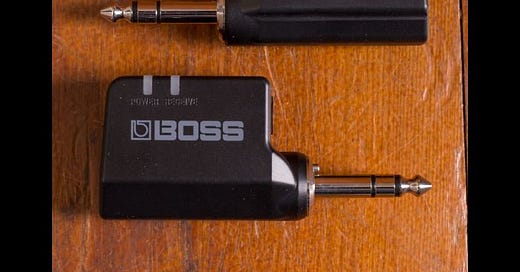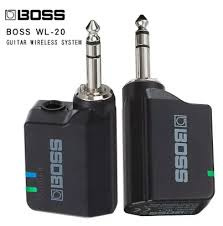Hi guys, here is Part 3 of my series Going Wireless With Your Electric Violin. If you haven’t read Part 1 or Part 2 yet, you can do so before reading this third segment.
Welcome to the conclusion of my three part series on Going Wireless! In this segment I will go over my second favorite, and actually most used, wireless system for my electric violin, the BOSS WL-20.
Even though it is my second favorite after the Line 6 G10S, why do I use this system more than the G10S?
Because in a sense, the WL-20 is more convenient to use than the G10S in that there is no charging “dock” to take up precious space on your pedalboard (it charges using a USB adapter), so you can use it when your pedalboard is already full of pedals, or you can plug it straight into an amp (so instrument direct to amp) without going through a pedalboard.
The WL-20 is super simple to use. You just plug the transmitter into the electric violin, and you plug the receiver into wherever you want the sound to go next, whether it is a pedal or an amp or a direct box or a mixer!
The WL-20 also has great battery life (up to 10 hours). I have never run out of battery in any set that I have played with it!
I use the WL-20 more than the G10S, because most of the time I am playing in small venues where I am not using my full size pedalboard with my G10S on it. I am using a smaller “travel-size” pedalboard because of space limitations (lack of room on a stage, or no stage at all!)
And when I am using a smaller pedalboard (with space only for 5-6 pedals) I don’t have room for the G10S dock, so hence, I am using the WL-20 to go wireless.
Using the WL-20 with my travel size pedalboard has worked for me over the years. I am very satisfied with this set up. The only negative is that I have to remember to charge my WL-20 with a USB adapter after each set. Charging is definitely not as convenient as with using the G10S dock!
Normally, I don’t have time to charge the WL-20 transmitter and receiver after my set. I am usually busy packing up or talking to folks. I wait until I get back home to charge. And sometimes, after I arrive home, I just chill and eat food, and hang out with my wife and children, and I forget to charge!
That’s when the WL-20 can become a problem. Several days later, when I am getting ready to play another small venue set, I realize that I had forgotten to charge my WL-20! So frantically I start charging it for 15 minutes before I step out the door, and I charge some more when I get to the venue. And when I start playing, the WL-20 is probably only half-charged (I don’t really know).
Nevertheless, I get through the set with no problem at all. And I breathe a sigh of relief. Praise God!
Other features of the WL-20: it offers a 10 foot cable tone simulation (so your tone is as if you are playing through a 10 foot instrument cable) and it has a 50 foot operating range. While the range is not as far as the G10S, it is more than enough for me as I am using it to play in small venues.
As I mentioned previously, using a wireless system is great for sound check as you can walk into the audience section and play and hear how you sound from there. That would be impossible to do when you are plugged into an instrument cable!
So folks, I would highly recommend the WL-20, but always remember to charge them right after you are done playing!
A final note, BOSS sells the WL-20 and the WL-20L. What’s the difference? The WL-20L doesn’t offer cable tone simulation, so it is primarily used for acoustic-electric guitars. I have both the WL-20 and the WL-20L, and I have tried them both for electric violin.
Without cable tone simulation, the sound is too bright for my taste (too much highs). I love the 10 foot cable tone simulation where it dampens the highs so the sound is more pleasing to the ear. The 10 foot cable tone simulation also works better when I use effects pedals. The sound is easier to work with effects.
So, in my opinion, the WL-20 is better for the electric violin than the WL-20L. I use the WL-20L with my acoustic-electric guitars and it works beautifully with those instruments.
Blessings to you! Until next time.





